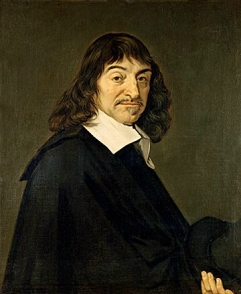Difference between revisions of "Rene Descartes"
m |
Jeremiah4-22 (Talk | contribs) (Merged with 'Descartes') |
||
| Line 1: | Line 1: | ||
[[Image:Gtr7564.jpg|right|thumb]] | [[Image:Gtr7564.jpg|right|thumb]] | ||
'''Rene Descartes''' (1596-1650) is known as the father of modern philosophy and [[algebraic geometry]]. He is most famous for his statement, "I think therefore I am" (in Latin, "Cogito, ergo sum"). A brilliant mathematician as well as a philosopher, Descartes viewed the mind as being in an unchallengable state very different from the body. | '''Rene Descartes''' (1596-1650) is known as the father of modern philosophy and [[algebraic geometry]]. He is most famous for his statement, "I think therefore I am" (in Latin, "Cogito, ergo sum"). A brilliant mathematician as well as a philosopher, Descartes viewed the mind as being in an unchallengable state very different from the body. | ||
| + | |||
| + | To write his famous ''Meditations on First Philosophy'', Descartes locked himself in a room and thought about existence, arriving at the conclusion that he, as a thinking person, must exist, because even if existence is a delusion, there must be someone to be deluded. However, he was still not sure that the things he perceived exist as well. He used a variant of [[Anselm]]'s proof of the existence of [[God]] to decide that perhaps he wasn't deluded, and perhaps things did exist after all. He thought the [[soul]] lived in the pineal gland, and when someone does something, it's just an accident because the brain doesn't control the body, God does. This "god-robot" theory of consciousness got him into arguments with [[Hobbes]]. He also used God and a demon in attempts to justify his sense-perceptions and why they were perceived to be as they seemed rather than as something different, which is related to Berkeley's [[idealism]] in the sense that it is the mind which has the ideas of objects, but conforms to the 'two-world' theory of [[John Locke]]. | ||
Descartes' most widely read work is his Discourse on Method (in French, "Discours de la methode"), published in 1637. There Descartes sets forth four rules for discovering knowledge: (1) accept as true only what can be proven, (2) solve problems in a systematic manner, part-by-part, (3) proceed from simple to more complex issues, and (4) finally, review everything completely to ensure that nothing was left out. | Descartes' most widely read work is his Discourse on Method (in French, "Discours de la methode"), published in 1637. There Descartes sets forth four rules for discovering knowledge: (1) accept as true only what can be proven, (2) solve problems in a systematic manner, part-by-part, (3) proceed from simple to more complex issues, and (4) finally, review everything completely to ensure that nothing was left out. | ||
| Line 6: | Line 8: | ||
Descartes established a metaphysical basis for his philosophy, that all philsophical propositions derive from a self-evident certainty of the mind, as in "I think therefore I am." | Descartes established a metaphysical basis for his philosophy, that all philsophical propositions derive from a self-evident certainty of the mind, as in "I think therefore I am." | ||
| − | + | {{DEFAULTSORT:Descartes, Rene}} | |
| − | [[Category:Philosophers | + | [[Category:Philosophers]] |
[[Category:Mathematicians]] | [[Category:Mathematicians]] | ||
Revision as of 12:12, April 6, 2007
Rene Descartes (1596-1650) is known as the father of modern philosophy and algebraic geometry. He is most famous for his statement, "I think therefore I am" (in Latin, "Cogito, ergo sum"). A brilliant mathematician as well as a philosopher, Descartes viewed the mind as being in an unchallengable state very different from the body.
To write his famous Meditations on First Philosophy, Descartes locked himself in a room and thought about existence, arriving at the conclusion that he, as a thinking person, must exist, because even if existence is a delusion, there must be someone to be deluded. However, he was still not sure that the things he perceived exist as well. He used a variant of Anselm's proof of the existence of God to decide that perhaps he wasn't deluded, and perhaps things did exist after all. He thought the soul lived in the pineal gland, and when someone does something, it's just an accident because the brain doesn't control the body, God does. This "god-robot" theory of consciousness got him into arguments with Hobbes. He also used God and a demon in attempts to justify his sense-perceptions and why they were perceived to be as they seemed rather than as something different, which is related to Berkeley's idealism in the sense that it is the mind which has the ideas of objects, but conforms to the 'two-world' theory of John Locke.
Descartes' most widely read work is his Discourse on Method (in French, "Discours de la methode"), published in 1637. There Descartes sets forth four rules for discovering knowledge: (1) accept as true only what can be proven, (2) solve problems in a systematic manner, part-by-part, (3) proceed from simple to more complex issues, and (4) finally, review everything completely to ensure that nothing was left out.
Descartes established a metaphysical basis for his philosophy, that all philsophical propositions derive from a self-evident certainty of the mind, as in "I think therefore I am."
